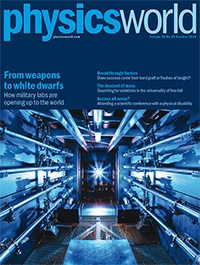The simultaneous drop of two dissimilar masses is one of the oldest experimental results. But new techniques may show that not everything falls the same way
 What goes up must come down. But does everything come back down at the same time? Galileo said yes. Newton said yes. Einstein said yes. Still, many physicists today secretly believe the answer might be no.
What goes up must come down. But does everything come back down at the same time? Galileo said yes. Newton said yes. Einstein said yes. Still, many physicists today secretly believe the answer might be no.
That belief might seem strange. Countless experiments over the years have concluded that two objects dropped from a height will – regardless of their composition – fall to the ground at precisely the same moment, provided they do not suffer disparities in air resistance. Schoolchildren are routinely taught about this “universality of free fall”, often with reference to the famous 1971 video of the US astronaut David Scott standing on the Moon and demonstrating that, in the absence of any air, even a feather and a hammer fall in unison. If the universality is not clear from everyday experience, it is at least implied by Newton’s laws of motion and gravitation, which combine to suggest that the acceleration of a body due to gravity is proportional only to the mass of the planetary object it is being attracted to, not to its own mass. The conclusion would appear irrefutable.
Yet, some violation of the universality of free fall could come in very useful. One of the greatest obstacles to progress in physics is the gaping chasm between the classical world of Einstein’s gen- eral theory of relativity, our current best theory of gravity, and the fuzzy, largely microscopic world of quantum mechanics, which accurately describes the other three known forces of nature: electromag- netism; and the strong and weak nuclear forces. A bridge between the two worlds – a quantum theory of gravity – is the neatest theoretical solution, but it has been elusive. Some candidate theories would seem to entail additional forces that, at very fine timescales, create an imbalance in the pull of gravity for different objects. Indeed, the observation of a tiny and hitherto imperceptible difference in acceleration for two falling objects could be the first evidence that general relativity is flawed, ushering in a new paradigm in modern physics.
Before the turn of this century, the best tests of gravitational free fall could find no deviation in the acceleration of two masses to within one part in 10 trillion. But a new host of lab- and space-based experiments promises up to a 10 000-fold increase in this precision, potentially offering the first chance of testing quantum gravity theories. What is more, some experimentalists are presenting new ways to approach tests of free fall – for example, by employing purely quantum systems, or antimatter. The question “Does everything fall back to Earth at the same speed?” may soon have an answer far more accurate than ever before. […]
To read the rest of this article, please contact Jon Cartwright for a pdf.